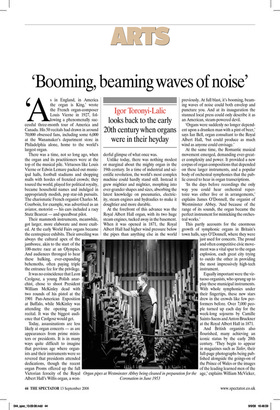‘Booming, beaming waves of noise’
Igor Toronyi-Lalic looks back to the early 20th century when organs were in their heyday
‘As in England, in America the organ is King,’ wrote the French organ-composer Louis Vierne in 1927, following a phenomenally successful three-month tour of America and Canada. His 50 recitals had drawn in around 70,000 obsessed fans, including some 6,000 at the Wanamaker’s department store in Philadelphia alone, home to the world’s largest organ.
There was a time, not so long ago, when the organ and its practitioners were at the top of the musical pile. Virtuosos like Louis Vierne or Edwin Lemare packed out municipal halls, football stadiums and shopping malls with hordes of frenzied crowds; they toured the world, played for political royalty, became household names and indulged in appropriately modish, pop star-ish pursuits. The charismatic French organist Charles M. Courboin, for example, was advertised as an aviator, motorist — his cars included a racy Stutz Bearcat — and speedboat pilot.
It was no coincidence that Leon Czolgosz, a young Polish anarchist, chose to shoot President William McKinley dead with two rounds of his pistol at the 1901 Pan-American Exposition at Buffalo, while McKinley was attending the opening organ recital. It was the biggest audience that Czolgosz would get.
Today, assassinations are less likely at organ concerts — as are appearances from prime ministers or presidents. It is in many ways quite difficult to imagine that previous age where organists and their instruments were so revered that presidents attended dedications, though the recent organ Proms offered up the full Victorian ferocity of the Royal Albert Hall’s Willis organ, a won derful glimpse of what once was.
Unlike today, there was nothing modest or marginal about the mighty organ in the 19th century. In a time of industrial and scientific revolution, the world’s most complex machine could hardly stand still. Instead it grew mightier and mightier, morphing into ever-grander shapes and sizes, absorbing the latest knowledge on pneumatics, electricity, steam engines and hydraulics to make it doughtier and more durable.
At the forefront of this advance was the Royal Albert Hall organ, with its two huge steam engines, tucked away in the basement. When it was opened in 1871, the Royal Albert Hall had higher wind pressure below the pipes than anything else in the world previously. At full blast, it’s booming, beaming waves of noise could both envelop and puncture you. And at its inauguration the stunned local press could only describe it as an American, steam-powered devil.
‘Organs were suddenly no longer dependent upon a drunken man with a pint of beer,’ says Ian Bell, organ consultant to the Royal Albert Hall, ‘but could produce as much wind as anyone could envisage.’ At the same time, the Romantic musical movement emerged, demanding ever-greater complexity and power. It provided a new corpus of organ compositions that depended on these larger instruments, and a popular body of orchestral symphonies that the public craved to hear in organ transcriptions.
‘In the days before recordings the only way you could hear orchestral repertoire was either live or in arrangements,’ explains James O’Donnell, the organist of Westminster Abbey. ‘And because of the range of its sounds, the organ became the perfect instrument for mimicking the orchestral works.’ This partly accounts for the enormous growth of symphonic organs in Britain’s town halls, says O’Donnell, where they were just used for concerts. The proud and often competitive civic movement was a vital spur to the organ explosion, each great city trying to outdo the other in providing the most impressively high-tech instrument.
Equally important were the virtuoso organists, who sprung up to play these municipal instruments. With whole symphonies under their fingertips, these new stars drew in the crowds like few performers before. Over 7,000 people turned up each day for the week-long sojourns by Camille Saints-Saens and Anton Bruckner at the Royal Albert Hall in 1871.
And British organists also flourished, many achieving an iconic status by the early 20th century. ‘They begin to appear in magazines such as Tatler, their full-page photographs being published alongside the goings-on of the Prince of Wales or the images of the leading learned men of the age,’ explains William McVicker,










































































 Previous page
Previous page